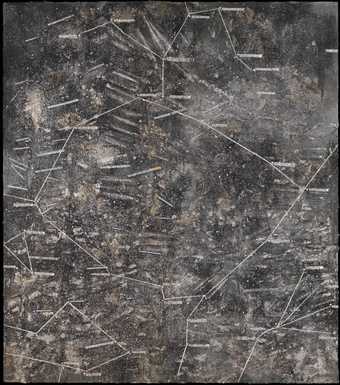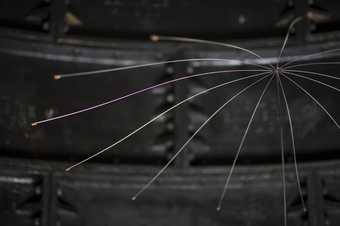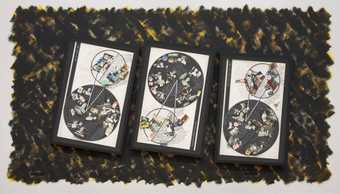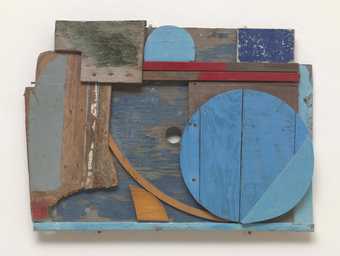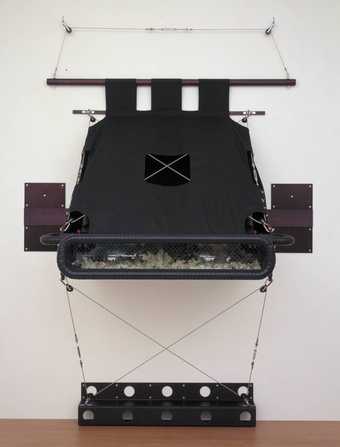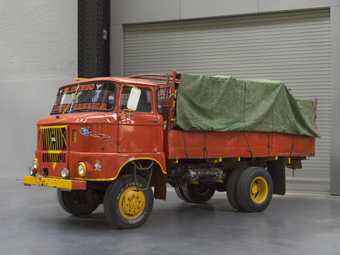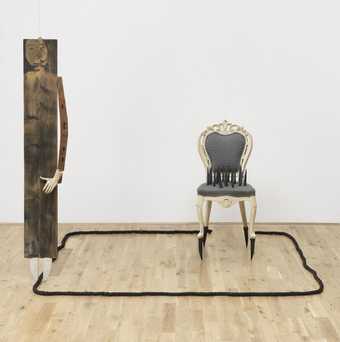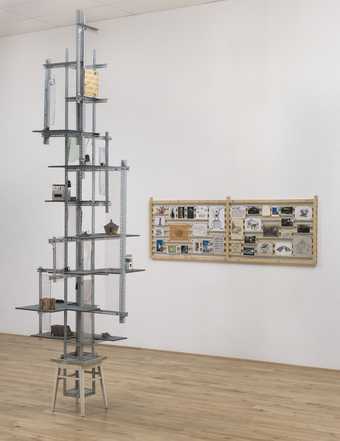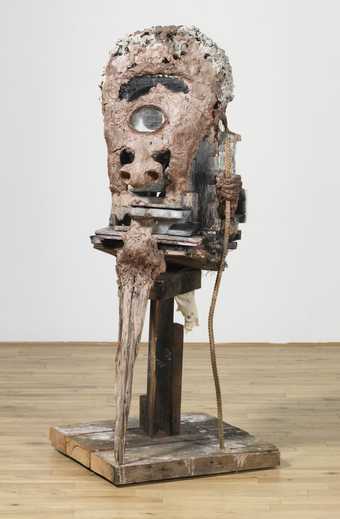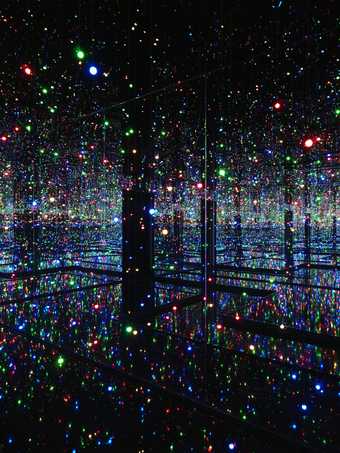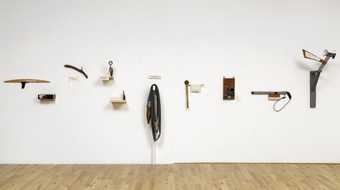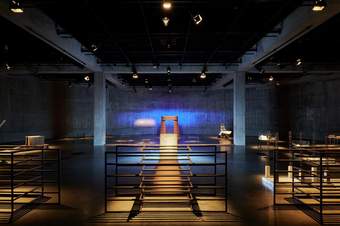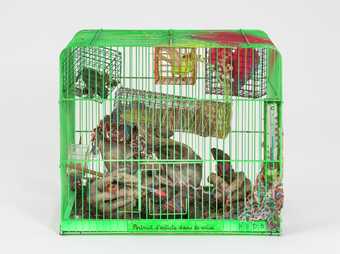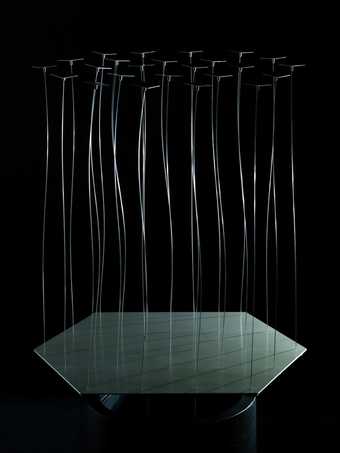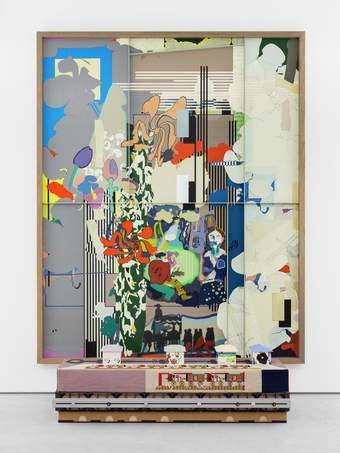In Tate Liverpool
Democracies
Free- Artist
- Xiao Lu born 1962
- Medium
- Aluminium, 2 screenprints on glass, mirrors, concrete, wood, paint, and other materials
- Dimensions
- Object: 2350 × 2780 × 3010 mm
- Collection
- Tate
- Acquisition
- Presented by Leo Shih 2017
- Reference
- T15540
Summary
Dialogue is an installation that comprises two life-size aluminium alloy telephone booths, a mirror, a pedestal, a red telephone and cement paving stones. On the left phone booth, an image of the back of a female figure holding a receiver is silkscreened over the glass, and on the right phone booth the back of a male figure is depicted. In the middle of the two phone booths is a red telephone on a white plinth, with the receiver dangling down. Behind the phone is a mirrored panel with two bullet holes referencing an action carried out by the artist when the work was displayed in the exhibition China/Avant-Garde at the National Art Gallery, Beijing in 1989. The sculpture is raised on cement paving stones, and purposely resembles the public phone booths found on the streets of China in the late 1980s.
This is a replica of the work made by Xiao Lu in 1989 for her graduation show at the Zhejiang Academy of Fine Arts in Hangzhou. The original was discarded by the artist in the 1990s. In 2003 she made an initial replica as a unique object, now in the collection of Taikang Life insurance company in China. In 2015, with permission from the owner, she decided to make a second replica – this time as an edition of three artist’s proofs with no main edition – to a slightly different scale from the first replica, being ten centimetres shorter in height. This copy is the second of these three artist’s proofs.
The China/Avant-Garde exhibition was a landmark event conceptualised in 1986 by a group of Chinese art critics and academics, with a focus on experimental and radical approaches to art. Unlike socialist realism or other academic styles that dominated artmaking in China at the time, this exhibition showcased new and more experimental forms of photography, installation and performance, as well as conceptual paintings and sculptures – representing the first generation of avant-garde artists in China. Almost three hundred artworks were included in the exhibition, all by Chinese artists, spread over the three levels of the National Art Gallery in Beijing. It opened on 5 February 1989, on the eve of Chinese New Year, but was shut down immediately by officials after Xiao Lu, unbeknownst to the exhibition preparatory committee or any of the exhibiting artists, shot two bullets of a pellet gun at the central mirror panel of her installation Dialogue. Xiao’s action caused a huge controversy and her immediate detention by the police, since using or carrying firearms is illegal in China, as well as the arrest of fellow artist Tang Song, who was at the scene. The incident was quickly picked up by the international press in Beijing, resulting in widespread news coverage. Alongside other unauthorised performances that occurred on the opening day of the exhibition by Wu Shanzhuan and Wang Deren, Xiao’s action provoked heated debates on the limits of artistic expression, and specifically performance art, in communist China.
Xiao’s ‘shooting’ performance was filmed by her friend Wen Pulin on his video recorder; a still photograph of the artist pointing a gun at the work exists as documentation of the performance and can be displayed alongside the installation. This image was produced in an edition of ten, but Tate’s copy is aside from this edition and of a different size. The documentation of Xiao’s performance has been shown in several international exhibitions including Inside Out: New Chinese Art at Asia Society Galleries and P.S.1 Contemporary Art Center in New York in 1998, and Global Conceptualism: Points of Origins 1950s–1980s at Queens Museum of Art, New York in 1999. The event remains one of the most mythologised moments in the history of Chinese contemporary art, especially evocative given the Tiananmen Square Massacre that would follow just four months after. When the Tiananmen Square Protest (also known as the June Fourth Incident in China) occurred, Xiao’s performance was quickly dubbed ‘the first gunshots of Tiananmen’, partly due to the close proximity of the National Art Gallery to the square.
At the time, Xiao’s action was presumed to be a political comment, but she later explained in her novel Dialogue (published in 2010) and several media interviews that it was more of a personal act related to her emotional and artistic anxiety. Discussing the subject matter of the Dialogue installation, she stated that, ‘I made Dialogue just because at the time I felt very stifled, really quite suffocated. I felt I could not communicate with men. Dialogue was about that.’ (In an interview with Tate researcher Monica Merlin, November 2013). The images of the woman and man with their backs turned away and the phone with its receiver dangling between them seem to suggest the absence or difficulty of communication between the sexes. Xiao’s later works, such as Sperm 2006 and Wedding 2009, show her continuing struggle with relationships and the conventional roles of women in Chinese society.
There is a view within the Chinese artistic community that Xiao’s shooting was an irresponsible act that overshadowed the ambition and purpose of the most experimental and modernist art exhibition in China up to that time, but her actions remain an iconic performance. The installation is a symbolic reminder of the new artistic ideals that enabled the organisation of the China / Avant-Garde exhibition and an important reflection of the political, social and artistic discourse taking place during a period of transition in China.
Further reading
Xiao Lu, Dialogue, Hong Kong 2010.
Hu Xiaolan, ‘Focus and Freeze – Revisiting Dialogue’, in Image, History, Existence: Taikang Life 15th Anniversary Art Collection Exhibition, exhibition catalogue, Culture and Art Publishing House 2011, pp.135–43.
Liau Shu Juan, ‘Redefining Art in the China / Avant-Garde Exhibition’, https://mondaymuseum.wordpress.com/2012/02/27/1989-china-avant-garde-exhibition/, accessed 17 July 2017.
Sook-Kyung Lee
July 2017
Does this text contain inaccurate information or language that you feel we should improve or change? We would like to hear from you.
You might like
-
Anselm Kiefer Cette obscure clarté qui tombe des étoiles
1999 -
Wen-Ying Tsai Umbrella
1971 -
Stephen Willats Are you Good Enough for the Cha Cha Cha?
1982 -
Margaret Mellis Number Thirty Five
1983 -
Ashley Bickerton Biofragment #2
1990 -
Ernesto Salmeron Auras of War
1996–2006 -
Yun Suknam Being Restricted I
1995 -
Tamás Kaszás Shanty Tower
2014 -
Huma Bhabha Man of No Importance
2006 -
Yayoi Kusama Infinity Mirrored Room - Filled with the Brilliance of Life
2011/2017 -
Jimmie Durham Untitled
1993–2012 -
Vivan Sundaram Memorial
1993–2014 -
Tetsumi Kudo Portrait of an Artist in Crisis
1980–1 -
Wen-Ying Tsai Cybernetic Sculpture: Square Tops
1969 -
Helen Marten The Age in Which We Love (Bulging the House)
2021


